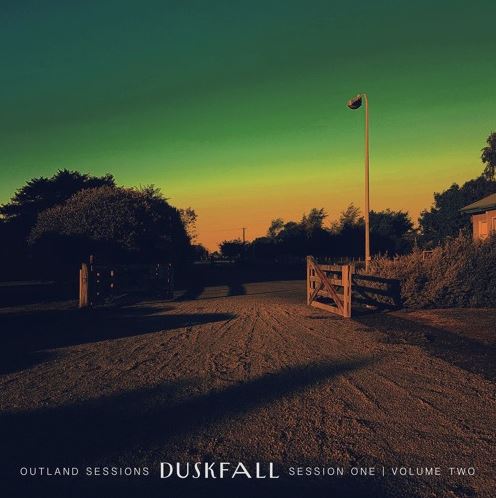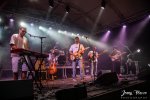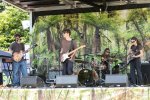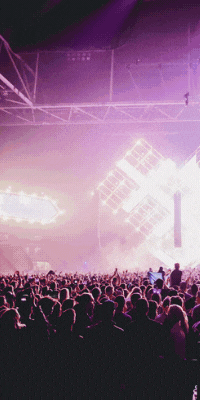Outland Sessions - EP Review: Duskfall

Duskfall is the title of these three acts, and as Paul T
Gheist ventured further into the Outlands, he finds himself in dark, yet
strangely familiar territory, filled with the fantastic and the odd...
1 – Alice Behind The 8 Ball
The first movement begins with jangly but doom-laden guitar
chords, with a stoner-type trudge provided by the drums. Though slow, the song
wastes no time in showing off main features: Lead singing that’s practically a replica
of Joshua Homme’s early vocals, and the mournful dual-harmonies of Jerry
Cantrell in the chorus.
As the song rolls along in the slow, lumbering rhythms, more
and more influences from Alice in Chains and Queens of the Stone Age peer
through the smoke, and one gradually realises the aptness of the title to this THC-laced
number.
The track’s stonerdom is perhaps best exemplified in the
echoing lyric “This body is just... This body is just a vessel”. The
juxtaposition of par-conscious lyrics combined with an out-of-body musical
drone makes for a nice, gloomy start to the EP.
2 – Takes So Much
Just before one decides that daylight had completely disappeared behind hills, the second track of this EP kicks in. Awakened by a swirl of major-key piano, drums and guitar at mid-tempo, this one is a bright contract against the doom of the opener.
Bearing a proud mark of Brit-rock, the song also ventures back
to a half-time rhythm in the middle, the mood then hoisted by high-register backing
vocals, and leading to a warm, reconciliatory finish.
The piano chords and the backing vocals invokes the bombast
of early Elton John, except folded with post-punk singing at the front of the
mix.
The song quickly ends on a trailing piano note, as though to
quickly hide from the oncoming dusk.
3 – Until The Sun's Death Kills Time
The song immediately captures attention with a soaring male
voice. Accompanied by drums and bass guitar, the shimmering keyboard arpeggios
takes the main focus of this piece.
Mid-way through, the song breaks into a rock waltz, creating
a passage of unusual tension, which is gently tightened further with the
addition of light violin tremolo strokes.
The lead singing never loosens its hold on one’s attention,
with a great style hybridised between the crisp falsettos of the late Chris
Cornell, added to the range and register of Serj Tankian.
But just as one considers the track concluded, it suddenly launches
into an epic, “November Rain”-like orchestral arrangement of the song. The
theatrical ending is a definite highlight of this EP, however, unlike the Guns
n’ Roses classic, this conclusion is woefully short. A finishing move so
dramatic deserves more than a swift thirty seconds!
4 – 8-Bit Nightmare
Without a doubt the most unusual and unexpected entry to the sessions so far, this one is an instrumental homage to 8- and 16-bit videogames of a bygone era, albeit with an art-rock vibe.
The deep layers of over-filtered sound make for a very tense
listen, and goes beyond just another imitation of Super Mario Bros. In minor
key, attacks come from high, middle and low-end of the sound spectrum, and in
the raspy nostalgic goodness only the most ancient of synths can produce.
Featuring a series of abrasively distorted riffs in the
middle, samples of evil laughter and even a bleep-bleep rhythm resembling Led
Zeppelin’s “Immigrant Song”, the adventurous and cinematic quality would make a
great match to a short film about someone trapped in a vintage arcade game.
Though weird, this is definitely one to stop by and check
out; this may even become a favourite out of the EP's for those appreciative of
generally-orthodox compositions.
5 – Ashes
If one is craving a good, honest heavy metal tune, be
sure to stop by this fifth track. The first metal song on the EP's so far, and very
little time is taken before scream vocals tear through by surprise. And female
scream vocals too!
A nice, powerful blend of palm-muted guitars and grooved
drumbeats, all in support of the lead singing voice, interchanging between
clean and harsh vocal styles.
Everything about this song screams (pun intended) of Kiwi metal
favourites, Devilskin, from the backing refrain vocals to the guitar solo, and
the headbang-worthy grooves.
The only puzzling feature of this track is the slight echo heard
in the clean singing during verses, as though it was recorded in a hallway...
Which would be perfect if it’s to intentionally summon vibes of an abandoned building!
6 – It's A Good Day To Rot
In a continuation of harsher singing styles, this one is
also a pounding, in-your-face number. Given the song title and a short play-length
of two minutes fifty, one could immediately sense the oncoming punk assault.
This one is a breed of equal parts grunge and punk (were the
two genres in their infancy really so different?). The verses ring with the
nasally snarls of Smashing Pumpkins’ Billy Corgan, with angry, staccato guitar
riffs, plus sharp punk lyrics and choruses that howl and shriek in the way
Nirvana became renowned for.
This one is also an easy song to headbang to at a dive bar, as
the piercing attitude edges one on to take another swig of beer and loosen up
one’s neck muscles.
At its conclusion, the piece mentally unravels and cuts its
own leash, the mood and tone then completely descends to a youthfully
discordant ending.
7 – Face To Face
Much like the first episode, this EP also closes with an
instrumental. Composed entirely of a keyboard, synths and drums, building upon
a creepy piano riff that bears potential as soundtrack to a movie montage.
The track starts off slow but steady, eerie with a mildly
meditative air to the repeated keyboard strokes.
Not long after the drums enter, the doom-inspired tones
gradually become more prominent, but evolves into machine-like march. At this
point, one begins to notice the experimental approach that’s been taken, and
within moments, the tempo and time signature have shifted again.
To lift things out of perspective, the keyboard synthesiser
suddenly kicks in, and the track goes interdimensional, creating a cosmic, Pink
Floyd-like atmosphere.
Whilst backed with technically-detailed drumming, after a
while, one starts to crave the sound of distorted guitars to carry the Opeth-like
feel, and to counteract the repetitive keyboard notes.
Clocking in over seven minutes long, this track is excellent
if one is looking for a detailed study in experimental rock duelled between
drums and a keyboard; with even a couple more instruments added to the mix,
this piece would make for a great musical soundscape.
Tuning Down, Rounding Up
Equally as eclectic as the first EP, but more grungy and
muddy. In the metaphor of journeying through the wilderness, we’re straying into
swamps and dense scrubland, and night time is falling.
Tension is ratcheted up several notches compared to the
first act; every track bears a different kind of intensity to it, be it in emotional,
instrumental, digital forms, or in an atmospheric sense.
There are clear influences from Smashing Pumpkins, Queens of
the Stone Age, several nods to early grunge bands, plus a noticeably Devilksin-esque number. Oh, and a quirky but creative video-game soundtrack set
right in the middle, as though 16-bit alien invaders had crash-landed in the
Outlands?!
For the review of Outland Sessions EP 1: Daylight, click here.
Review written by Paul T Gheist
Other Reviews By Steve Shyu
 Mt Eden - EP Review: Venom
Mt Eden - EP Review: Venom
24 Dec 2024 // by Steve Shyu
Anyone who knows anything about Aotearoa electronic music will be very familiar with the name Jesse Cooper. Or as he’s better known, Mt Eden - Formerly Mt Eden Dubstep.
Read More...
 Zuke - Album Review: Come Closer
Zuke - Album Review: Come Closer
16 Dec 2024 // by Steve Shyu
Ed Zuccollo, stage name Zuke, is a renowned producer and master of synthesisers based in Whanganui-a-Tara Wellington. He’s also known for his work with the likes of Trinity Roots, is also a member of KITA, and has made marks in his solo DJing career, performing at festivals such as Northern Bass, Splore, KiwiBurn, AUM and loads more.
Read More...
 Jacob Blair Tait - EP Review: Our Great Nation
Jacob Blair Tait - EP Review: Our Great Nation
24 Nov 2024 // by Steve Shyu
You wouldn't be able to guess what sort of music you’re in for just by looking at the cover artwork. Hues of aquamarine and purple dominate, and in the centre, an artistic rendering of a million marching soldiers bearing flags, albeit created using AI.
Read More...
28 Oct 2024 // by Steve Shyu
DougFest is back. Bigger, bolder, and heftier than the first.
Read More...
 Muriwai - Album Review: Muriwai
Muriwai - Album Review: Muriwai
02 Oct 2024 // by Steve Shyu
Muriwai is the latest undertaking by Bob Bickerton and Ariana Tikao, a new and greatly anticipated collaboration in Aotearoa’s world of traditional music. Bob is a highly influential sound engineer, performer, educator, a Member of the New Zealand Order of Merit for services to music, and composer who has worked in the New Zealand music industry for almost 50 years.
Read More...
 Fan Club - EP Review: Towards The Sun
Fan Club - EP Review: Towards The Sun
09 Jul 2024 // by Steve Shyu
2024 is set to be another monumental year for Tamaki Makaurau’s Fan Club. Just last year they claimed a multitude of awards, including the top prize at Raise Up’s New Found Sound, and placing first in the Auckland Central Final of the SmokeFree RockQuest.
Read More...
 Havening - Double Album Review: Wavelengths of Light
Havening - Double Album Review: Wavelengths of Light
26 May 2024 // by Steve Shyu
Big things are happening for Bonnie O'Donnell. Under her alias of Havening, she’s been eagerly crafting bucketloads of electronic music, releasing them all as not one, but two albums.
Read More...
18 Mar 2024 // by Steve Shyu
With nothing of last night's rainstorm in sight except puddles in the asphalt, the sun warmed the air to counter the day's cold breeze. There was plenty of talk of a cold snap on the way, but I was confident my tee and hoodie combo would suffice.
Read More...
Most Viewed Artists
Latest Galleries

Evan Rhys & the Stereo Streets @ Festival of Lights - Pukekura Park, New Plymouth - 18/01/2025
Midwave Breaks @ Festival of Lights - Pukekura Park, New Plymouth - 18/01/2025
Rumpus Machine @ Music in Parks, Aotea Square, Auckland - 18/01/2025
Fan Club @ Music in Parks, Aotea Square, Auckland - 18/01/2025
NZ Top 10 Singles
- APT.
ROSÉ And Bruno Mars - DIE WITH A SMILE
Lady Gaga And Bruno Mars - BIRDS OF A FEATHER
Billie Eilish - TASTE
Sabrina Carpenter - I LOVE YOU, I'M SORRY
Gracie Abrams - ESPRESSO
Sabrina Carpenter - SAILOR SONG
Gigi Perez - LOSE CONTROL
Teddy Swims - A BAR SONG (TIPSY)
Shaboozey - GOOD LUCK, BABE!
Chappell Roan




 Report A Problem
Report A Problem

